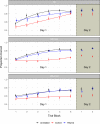Is that a pibu or a pibo? Children with reading and language deficits show difficulties in learning and overnight consolidation of phonologically similar pseudowords
- PMID: 32691904
- PMCID: PMC7988620
- DOI: 10.1111/desc.13023
Is that a pibu or a pibo? Children with reading and language deficits show difficulties in learning and overnight consolidation of phonologically similar pseudowords
Abstract
Word learning is critical for the development of reading and language comprehension skills. Although previous studies have indicated that word learning is compromised in children with reading disability (RD) or developmental language disorder (DLD), it is less clear how word learning difficulties manifest in children with comorbid RD and DLD. Furthermore, it is unclear whether word learning deficits in RD or DLD include difficulties with offline consolidation of newly learned words. In the current study, we employed an artificial lexicon learning paradigm with an overnight design to investigate how typically developing (TD) children (N = 25), children with only RD (N = 93), and children with both RD and DLD (N = 34) learned and remembered a set of phonologically similar pseudowords. Results showed that compared to TD children, children with RD exhibited: (i) slower growth in discrimination accuracy for cohort item pairs sharing an onset (e.g. pibu-pibo), but not for rhyming item pairs (e.g. pibu-dibu); and (ii) lower discrimination accuracy for both cohort and rhyme item pairs on Day 2, even when accounting for differences in Day 1 learning. Moreover, children with comorbid RD and DLD showed learning and retention deficits that extended to unrelated item pairs that were phonologically dissimilar (e.g. pibu-tupa), suggestive of broader impairments compared to children with only RD. These findings provide insights into the specific learning deficits underlying RD and DLD and motivate future research concerning how children use phonological similarity to guide the organization of new word knowledge.
Keywords: artificial lexicon; consolidation; developmental language disorder; phonological competition; reading disability; word learning.
© 2020 The Authors. Developmental Science published by John Wiley & Sons Ltd.
Conflict of interest statement
The authors declare no competing financial interests.
Figures





References
-
- Allopenna, P. D. , Magnuson, J. S. , & Tanenhaus, M. K. (1998). Tracking the time course of spoken word recognition using eye movements: Evidence for continuous mapping models. Journal of Memory and Language, 38(4), 419–439. 10.1006/jmla.1997.2558 - DOI
-
- Alt, M. , Gray, S. , Hogan, T. P. , Schlesinger, N. , & Cowan, N. (2019). Spoken word learning differences among children with dyslexia, concomitant dyslexia and developmental language disorder, and typical development. Language, Speech, and Hearing Services in Schools, 50(4), 540–561. 10.1044/2019_LSHSS-VOIA-18-0138 - DOI - PMC - PubMed
Publication types
MeSH terms
Grants and funding
LinkOut - more resources
Full Text Sources
Miscellaneous

